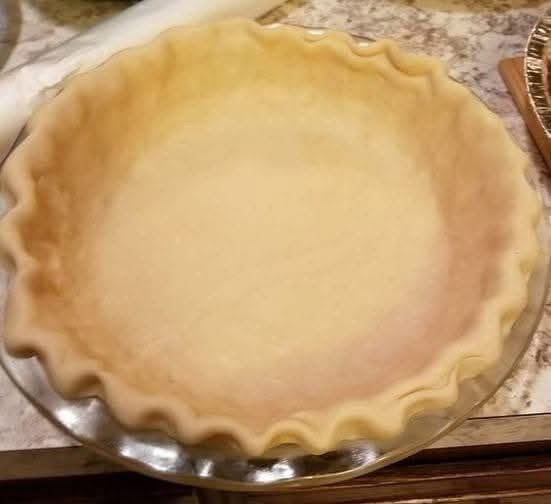THE ULTIMATE PIE CRUST
A BUTTERY, FLAKY EMBRACE OF TRADITION AND TASTE

Pie crust: the unsung hero of the baking world. It’s the quiet foundation that holds together the sweet and the savory, the comforting and the celebratory. Whether it’s the golden-brown base of your grandmother’s apple pie or the rich, buttery shell of a savory quiche, a pie crust does more than just hold fillings—it holds memories. Making a pie crust from scratch is a time-honored tradition that connects us to centuries of culinary history. It reminds us of home kitchens filled with the scent of melted butter, floured countertops, and the anticipation of that first slice.
HISTORY OF PIE CRUST
The history of pie crust spans thousands of years. It started with the ancient Egyptians, who used a coarse paste of ground oats or barley to wrap around meat before baking. These early “crusts” weren’t eaten—they were more like edible pots. As time passed, the Greeks and Romans improved the method, eventually incorporating oil and later butter into their doughs. By medieval times in England, pie crusts were known as “coffyns,” sturdy pastry shells used to preserve meats and fillings over time. They were thick and heavy—more function than flavor. It wasn’t until the 16th century, with the increased availability of butter and lard, that pie crusts began to resemble the tender, flaky delicacies we know today. As pies made their way to the Americas, they adapted to local ingredients and became staples in American cuisine. Apple pie, pumpkin pie, chicken pot pie—these aren’t just dishes. They’re part of cultural identity, served on holidays, special occasions, and family gatherings.
INGREDIENTS
To make one perfect 9-inch pie crust, you’ll need:
1 1/4 cups (150 grams) all-purpose flour.
1/2 cup (115 grams) unsalted butter, cold and cut into small cubes.
1/4 teaspoon salt.
1/2 tablespoon sugar (optional, especially for sweet pies).
3 to 5 tablespoons ice water.
INSTRUCTIONS AND METHOD
Start by placing the flour, salt, and sugar (if using) into a large mixing bowl. Add the cold butter cubes and begin cutting them into the flour using a pastry cutter, two forks, or your fingers. Work quickly to avoid melting the butter. You want the mixture to look like coarse crumbs with pea-sized bits of butter scattered throughout. Slowly add ice water, one tablespoon at a time, mixing gently with a fork until the dough just comes together. Be careful not to overwork the dough—you want to keep those pockets of butter intact, as they’re what make your crust flaky. Once it comes together, shape the dough into a disk, wrap it tightly in plastic wrap, and chill it in the fridge for at least one hour. When ready, roll the dough out on a lightly floured surface to about 12 inches in diameter for a 9-inch pie plate. Transfer it gently into the pie plate, trim the excess dough, and crimp or flute the edges. For a blind-baked crust (as shown in your image), line it with parchment paper, fill with pie weights or dried beans, and bake at 375°F (190°C) for 15-20 minutes. Remove the weights and bake for an additional 10 minutes, or until lightly golden.
BENEFITS OF HOMEMADE PIE CRUST
Making your own pie crust is not only cost-effective but also allows full control over the ingredients. No preservatives, no hydrogenated oils—just real butter, flour, and love. The taste is incomparably better: buttery, flaky, and tender. Plus, there’s a sense of pride and satisfaction in mastering a fundamental baking technique that elevates every pie you make.
PIE CRUST FORMATION
The magic behind a flaky crust lies in how the butter is worked into the flour. When cold butter melts in the oven, it creates steam, which lifts the layers of dough and results in that perfect flake. That’s why keeping the butter cold and not overworking the dough is so essential. You’re essentially building layers of love—one flake at a time.
NUTRITIONAL INFORMATION
A standard single-serving slice (1/8 of a 9-inch pie crust) contains approximately:
180–220 calories
12g fat (mostly from butter)
18g carbohydrates
1g protein
0g fiber
Keep in mind, the nutrition can vary slightly based on how much butter you use and the type of flour. Though not a “health food,” pie crust in moderation is a delightful indulgence that fits into a balanced diet.
LOVERS OF PIE
Pie lovers are a special kind. They’re nostalgic, they’re warm-hearted, and they know that good things come in circular forms. Pie brings people together. Whether you’re into a gooey pecan pie, a tart lemon meringue, or a comforting shepherd’s pie, there’s something about crust that brings a dish full circle—literally and emotionally. Lovers of pie know that life is better when it’s wrapped in pastry.
CONCLUSION
A pie crust is more than flour and butter—it’s tradition, craft, and comfort all in one. It’s the golden gateway to desserts and dinners that stick in your memory like the last bite of a holiday meal. It teaches patience, precision, and creativity. The next time you’re craving something soulful, take the time to make your pie crust from scratch. You won’t just be baking. You’ll be continuing a centuries-old tradition—one delicious, flaky layer at a time.